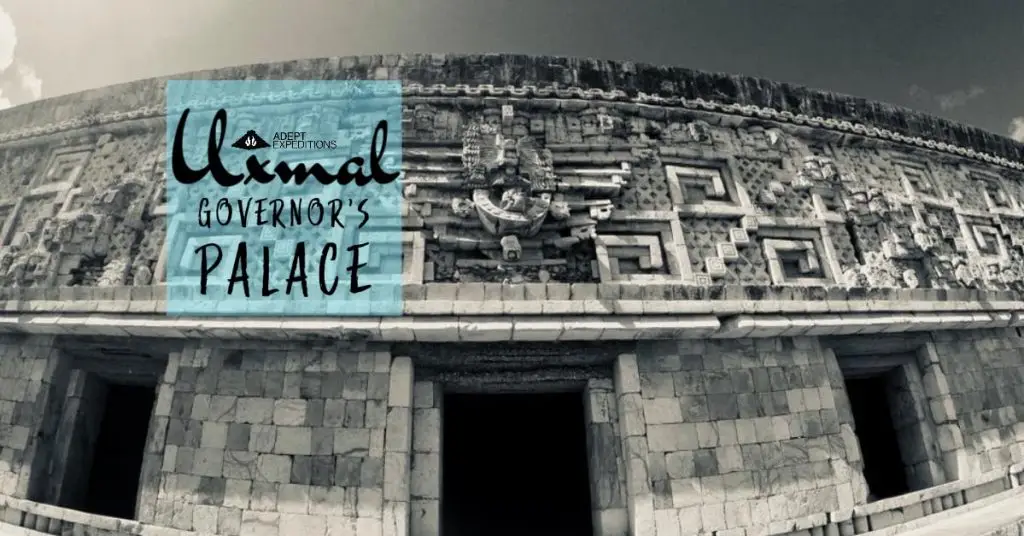The Governor's Palace in Uxmal

The Governor’s Palace in Uxmal is a monumental masterpiece and a must-see along with the Pyramid of the Magician and Nunnery Quadrangle. Many travelers consider it to be a perennial favorite as it represents the highest expression of Puuc architecture, but for me, it’s all about the elaborate serpentine symbolism and astronomical alignments.
Its elevated status clearly makes it one of the most imposing palaces in Uxmal. However, the palace presents some perplexing enigmas and the deeper you look, the more mysterious they become.
General description of the Governor’s Palace in Uxmal
To begin with, the Governor’s Palace is comprised of three platforms and three buildings linked by tall transverse vaults with arrow-shaped corbel arch entrances. At the base, a massive man-made mound measuring a mind-boggling 187 meters (613.5 feet) long, 170 meters (558 feet) wide, and 8-10 meters (26-33 feet) high supports another 7-meters/23-foot-high platform providing support for the master palace itself measures 98 meters (321.5 feet) long and 12 meters (39 feet) wide which then divides into three — perhaps giving meaning to the city’s indigenous name “three times built”.

And finally, the orientation of the Governor’s Palace is a radical departure from the other ruins in Uxmal which all happen to conform the same alignment oriented on a north-east axis. Unlike the others — such as the Nunnery Quadrangle, the Ball Court, and terrace-mate, the House of Turtles, the Governor’s Palace stands alone on an east-southeast axis. Why such an unusual orientation?
Next, the House of the Governor is treated in traditional Puuc style — typical of the region — with a plain lower wall juxtaposed against a decorative upper frieze elaborately embellished with consecutive monster masks that bring vital life power to the palace while an undulating serpent slithers along the upper cornice. In contrast to the corners where masks are vertically stacked, the center masks run diagonally and horizontally to form a sequence of triangles that alternate with double “G-frets” to help compose a symphony in stone bringing harmony to the whole facade. In addition, Human figures — now mostly effaced — stand out against the latticework of lesser importance, although overall the entire composition conveys deep meaning reflected by its symbolic adornments.
According to some researchers the Governor’s Palace is not only an architectural jewel but an astronomical gem.
What did the ancient architects of Uxmal have in mind when they built the Governor’s Palace?

A clue can be found that begins to unlock the true purpose of the Governor’s Palace: an iconographic element adorning the many monster masks resembling the Maya glyph for Venus. Another is in the mythology of Quetzalcoatl, known to the Maya as Kukulkan. The legend relates how after the spiritual leader falls victim to a fire, the principle perishes in flame before Kukulkan is reborn as the planet Venus
In the western esoteric tradition, fire is understood as the initiating and transformative principle denoting death not as an ending, but as a transition to a new beginning. For the ancient Maya, the cycle of the planet Venus was linked with growth and vitality made possible by rainwater personified by Chac. The beginning of the rainy season coincides with the northerly extremes of the planet Venus symbolizing the continual process of death and rebirth. The planet first appears as the Evening star, disappears, then reappears as the Morning star.
When visiting the Governor’s Palace at Uxmal, you can try to locate the Venus glyph for yourself: look for what appears to be a set of eyes with squiggly lines located on the cheek of Chac. We always having fun letting our guests point them out during our symbolist study tours of the Yucatan. They are not hard to miss as the House of the Governor is adorned with almost 400 of these star glyphs.
I am providing this images of the Mayan Venus glyph below for your reference:


Now try to see if you can find the Venus glyph for yourself in the image below:
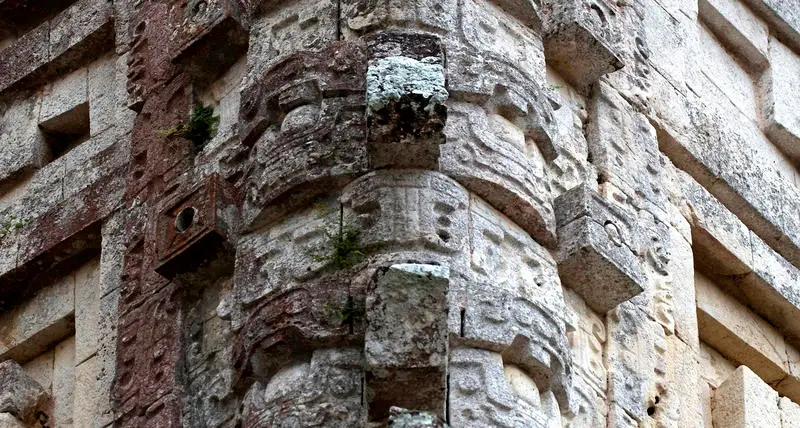
A controversy over the Maya Cosmovision
The Maya worldview or cosmovision encoded in the sacred art and architecture at Uxmal reflects observations in the relationships between celestial events and cyclical changes in the natural environment.
Understanding this point-of-view, Antony F. Aveni established a connection between Venus and the Governor’s Palace. According to the archaeoastronomer, “the alignment from the Governor’s Palace to Nohpat points almost exactly to the azimuth of Venus rise when the planet attained its maximum southerly declination around A.D. 750”. Aveni posited that the orientation of the Governor’s Palace was deliberately designed to align with the southernmost rising point of Venus as the morning star. This then became the accepted academic theory along with the understanding that the central doorway of the palace provided the perfect vantage point for observing this celestial event. Yet the matter is more complicated and more interesting than that.
A diametrically opposed theory by Archaeologist Ivan Sprajc overturned the prevailing paradigm. Sprajc argues that the alignment refers not to the southernmost extremes of the morning star but to the northerly extremes of the evening star. Aveni apparently confused a visible mound for the great pyramid at Nohpat, but that mound was actually the pyramid of Cehtzuc, a small site located nearly 5 km to the southeast. Given the approximate azimuth of 118°, the Governor’s Palace is actually oriented to that Cehtzuc so that when Venus as the evening star reached its maximum northerly extremes, it would have set behind the northern edge of the Governor’s Palace. Therefore the Governor’s palace was not the observatory but a marker for the ancient Maya.
The celestial event broadcasted the onset of the rainy season thus giving significance to hundreds of Venus glyphs marking the mask of the rain diety Chac. This occurred every eight years symbolized by the eight dual-headed serpents above the principal portal of the building’s facade. Pursuing this further, the Maya bar-and-three-dot symbol for the numeral eight can be observed on the northern corners of the palace depicted on the two Chac masks. This takes us another argument among scholars.

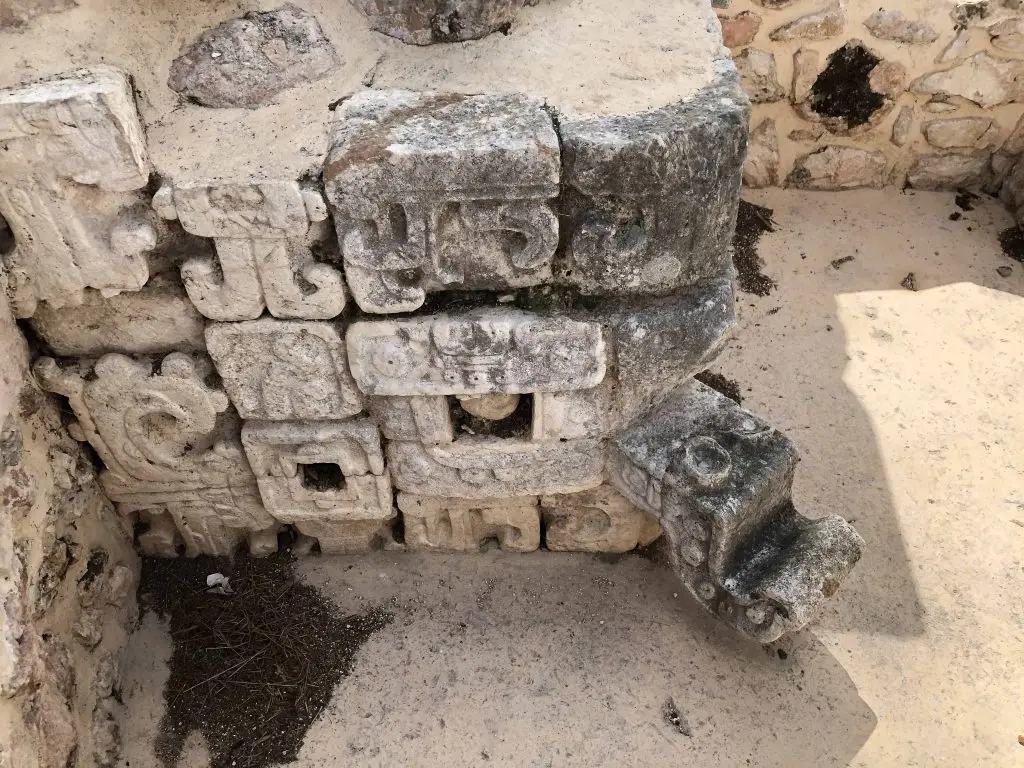
Will the real monster mask please stand up?
Long described as the Maya rain god Chac, many of the monster masks that adorn the corners of puuc architecture may not even be Chac. According to the groundbreaking research of archaeologist Karl Taube, the masks that have been mistakenly identified as Chac are actually iconographic mountains known as Witz.
The Witz mountain mask contains a headbands embedded with stylized flowers above the eyes parallel to one’s pineal gland or what Is commonly referred to as the third eye. In Maya ontology, they enliven the temples transforming the buildings they adorn into “Flower Mountain” or what Taube refers to as, “a solar celestial paradise, a shining place of flowers and beauty.” This third eye flower motif, sometimes represented by a star is abundant throughout Mesoamerica: from the Maya on the Yucatan Peninsula to the Mexica (Aztec) and Toltec of central Mexico. It even reaches into the indigenous cultures of North America. In fact, we see this symbolic expression repeated in cultures all over the world.
This theory was supported by Michael D. Coe in his books on the Ancient Maya so you may believe that it is now the academic standard, still, some scholars believe the masks at Uxmal may represent Kukulkan. And yet others believe the masks at Uxmal and Chichen Itza represent the principle Itzamna, the creator god of the sky in his role as the celestial bird, Itsam Kah or Itsam Yeh.

Whatever you believe the case to be, it only takes a single set of eyes to clearly see how beautiful the Governor’s Palace truly is. And when looking through the eyes of a symbolist, as we invite you to do during our esoteric symbolist study tours of the Yucatan, it becomes even easier to see why the Governor’s Palace is actually more than just beautiful. It’s inner meaning if properly understood enables a new dimension to open up before our eyes and in our heart.
Symbolist Interpretation of the Governors Palace in a Uxmal
I cover all of these topics walking the reader through detail-by-detail discussing the deeper esoteric aspects and providing a full symbolist interpretation of the Governor’s Palace in my book.
The book will help you get more out of every trip.
For now, here are some interesting facts about the Governor’s Palace and how to get there.
10 Fascinating facts about the Governor’s Palace in Uxmal
1. The earliest restoration project at Uxmal was the restoration of the exterior of the Governor’s Palace in 1927.
2. The frieze on the front (east) facade is the largest and composed of over 15,000 mosaic pieces of carved stone.
3. The earliest restoration project at Uxmal was the restoration of the exterior of the Governor’s Palace in 1927.
4. The Governor’s Palace was the last major structure completed at Uxmal; recognized as a structure “of incomparable nobility and balance.”
5. The typical Chac mask on the official plaque by INAH is accidentally shown upside down.
6. The cornice and medial binder molding run around the entire Palace.
7. Missing heads from Governor’s Palace sculptures are on display in the Museum of the Americas, in Madrid Spain.
8. A famous cast of the front portion of the vaulted passageway of the Governor’s Palace on display in1893 at Columbian Exposition in Chicago inspired Frank Lloyd Wright.
9. In 1841 Stephens and Catherwood found a 10-foot long wooden lintel, carved with hieroglyphs and took it to New York for display two years later. Two years after that it was destroyed in a fire.
10. Hieroglyphic inscriptions above the central doorway of the Governor’s Palace depict zodiacal constellations and its uppermost row map of the constellations at the time of the Venus alignment. The Throne Inscription from Uxmal may now be recognized as one of the major sources of information about the pre-Columbian Maya zodiac.
The Pillory Shrine in Uxmal
The Pillory Shrine is built upon a square pedestal and is composed of a cone-shaped cylindrical monolith that appears to have been covered with stucco and painted with symbolic motifs and hieroglyphs.
It has been referred to as a flogging block or whipping post from which it gets its name and you might believe that, still, there is, of course, a more suitable and symbolic explanation in which it represents the central tree or Axis Mundi of Maya mythology, manifested in the physical form as the Ya’ache Cab or ceiba tree common to the Puuc region.
I can understand this point of view, but it’s dimensions are larger. Another theory is that the stone is a phallic monument penetrating and fertilizing mother earth though archaeologists have found no compelling evidence for it to be identified as such. However, that is the one that resonates most with me. For now, it will remain a mystery and potential PHD study waiting for some bright scholar to come along and crack the code.
Throne of The Jaguar in Uxmal
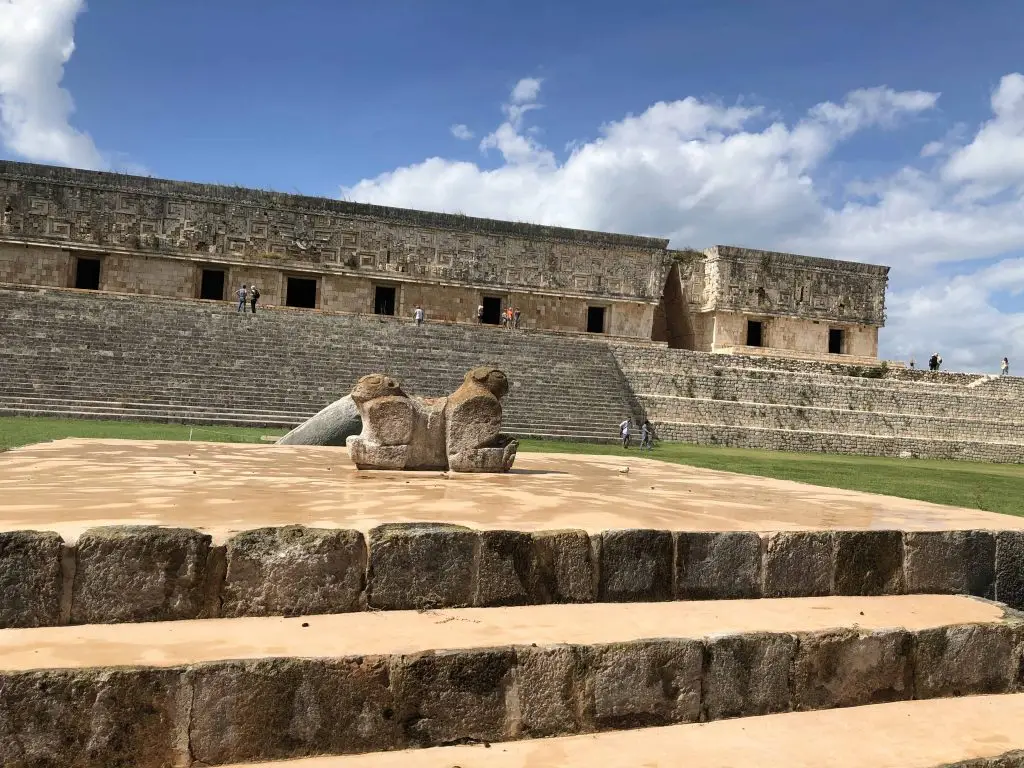
The Jaguar Throne is a limestone sculpture representing a bicephalic Jaguar composed of two heads facing away from one another and joined at the midsection. It appears to have been the seat of royal authority at Uxmal and marks ritual space in front of the Palace.
It oriented from north to south and centered on a small platform measuring 4.85 meters (15.7 feet) long and 1.2 meters (3.9 feet) high that could be accessed by four stairs on each side.
The platform rests upon the same artificial terrace as the House of Turtles, known as Platform 2, but the location directly in front of the House of the Governor along with its alignment on the central axis confirms the true nature of the building.
An ancient Sacbé (white road or raised causeway) extended from the base of the platform and ran through Nohpat teaching nearby Kabáh suggesting an intimidate and most likely ceremonial connection.
Stela 14 — now on display in the museum by the entrance of Uxmal — depicts Lord Chaak standing upon a double-headed jaguar throne which resembles the same sculpture in front of the House of the Governor. It becomes easy to imagine Lord Chac, ruler of Uxmal seated or standing on the throne representing the center of the Maya world reflecting the four-partite horizontal and the tripartite vertical orders of the cosmos.
The jaguar has symbolic connotations of warfare and royal and dynastic power in Maya iconography. Bicephalic imagery is also linked to Maya women who perform sacrificial bloodletting rites. Some people believe the dual-headed jaguar is a male principle, nevertheless, it may represent the earth goddess who brings the rains when she is pregnant with the new sun, and who like all mother goddesses of Central America, dies when the sun comes out, reborn from its bosom. Since the Maya followed a lunar calendar, the Jaguar a nocturnal animal, connected to their Goddess of the Moon, Ixchel who is sometimes depicted with the Jaguar claw.
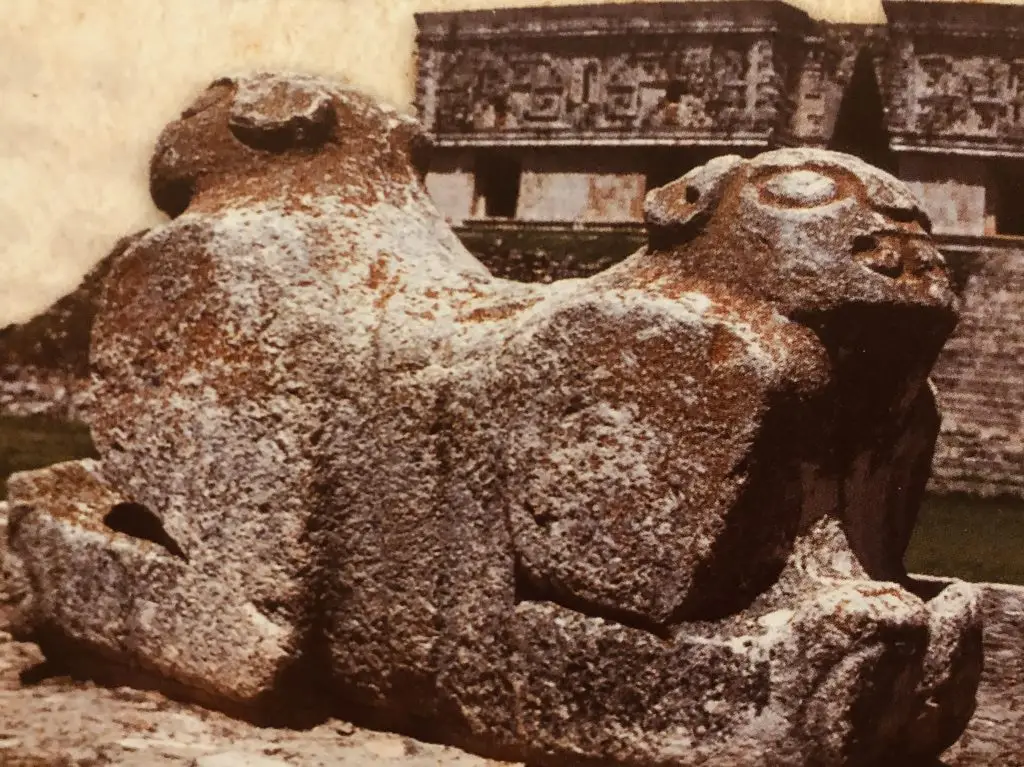
The Jaguars association with the night, and therefore occupy knowledge gave it the gift of second sight and prophecy, which explains why the bicephalic jaguar four eyes, two for normal sight and two for supernatural vision.
The Jaguar throne was a common symbol of shamanic authority among the Maya. For example, a similar dual-headed throne was discovered in Palenque. The finest example I have ever seen may be the single head jaguar throne hidden in the second substructure deep within the interior of El Castillo aka The Pyramid of Kukulkan at Chichen Itza.
When explorers John Lloyd Stephens and Frederick Catherwood visited Uxmal in 1839, Stephens documented his discovery of the artifact. He even tried to take the Jaguar throne but found it “too have to carry away” so it remains in situ for us to appreciate today. He evidently had no idea what was right under his nose — there, beneath the sculpture in the interior of the platform, a cache of valuable offerings remain hidden until 1951 when a team of archaeologists working on the site brought to light a total of 913 artifacts, including beads, pectorals, jade earrings, vessels, carnelian stone, polished black stone, spearheads, knives of flint and obsidian blades.
There is more to discover at the Governor’s Palace in Uxmal.
Recent Discoveries
A Recent Discovery Reveals a Secret Passage in The Governor’s Palace at Uxmal
During our most recent Adept Expeditions symbolist tour of the Yucatan, archaeologists restricted access to the south-eastern extremity of the Governor’s Palace in Uxmal as part of new excavation. A team of researchers from the National Institute of Anthropology and History (INAH) discovered a hidden passage measuring 25 meters (82 feet) and it’s estimated to date from 670-770 AD. Chac masks and the rains of three old staircases were also revealed.
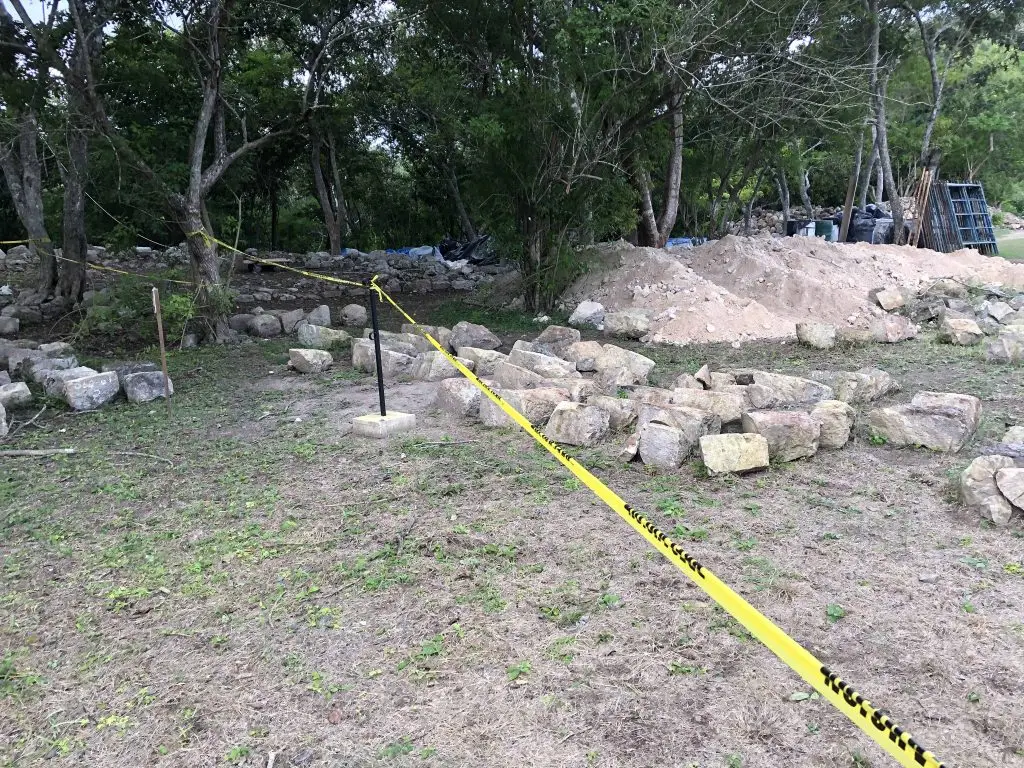
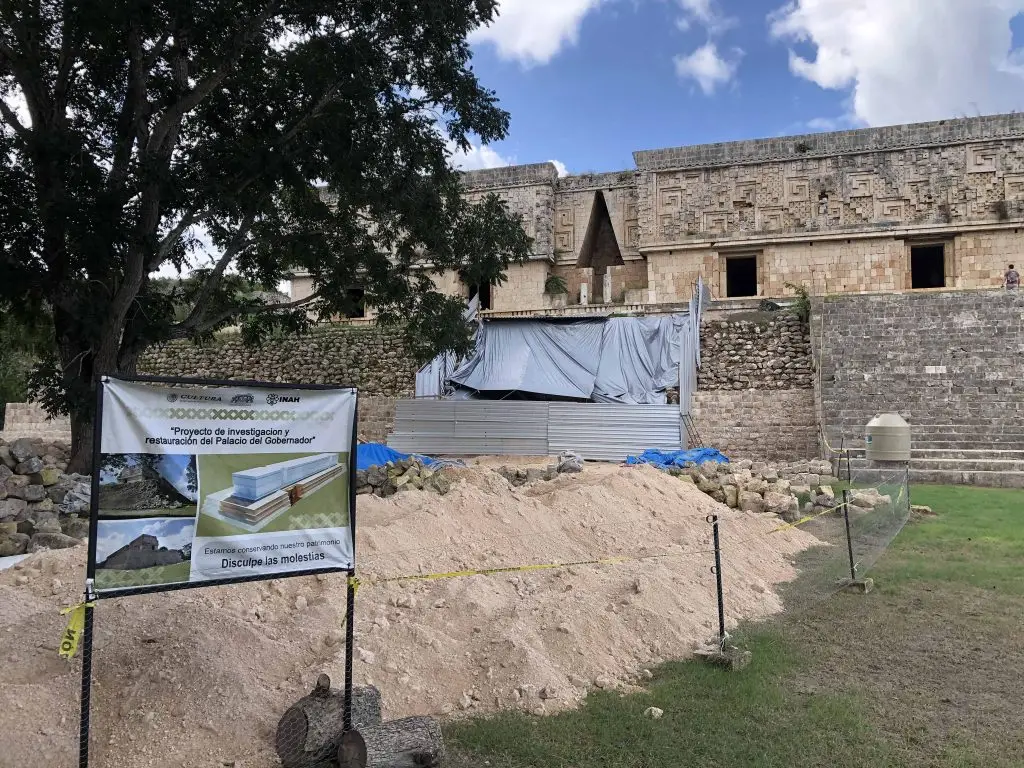



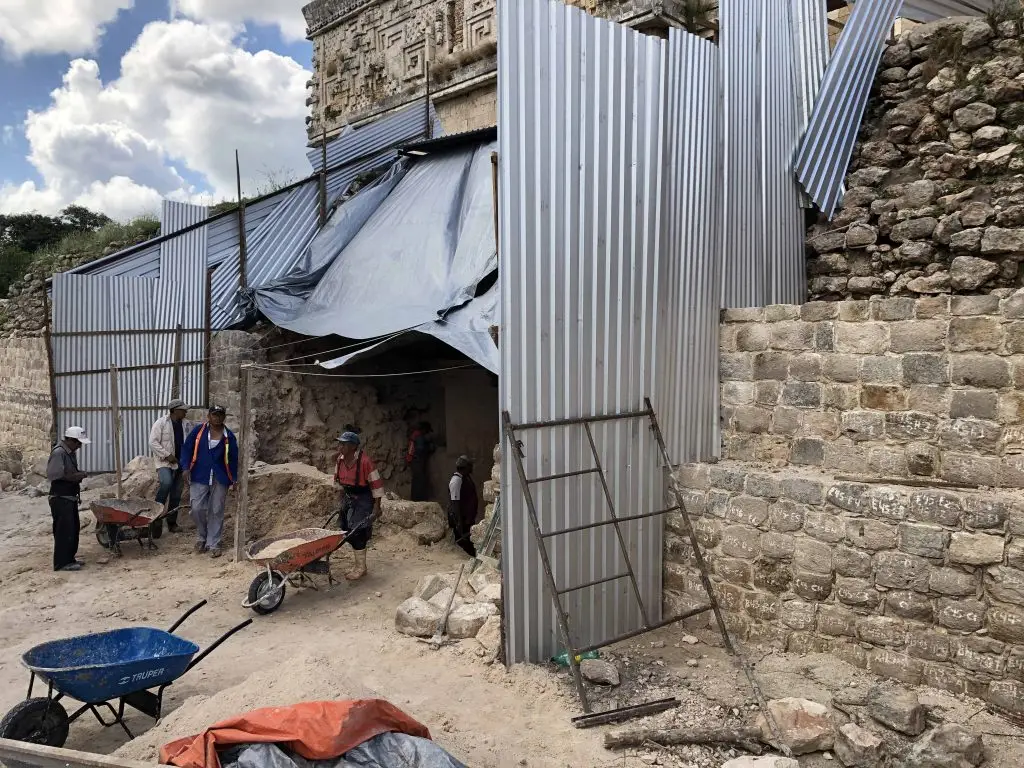

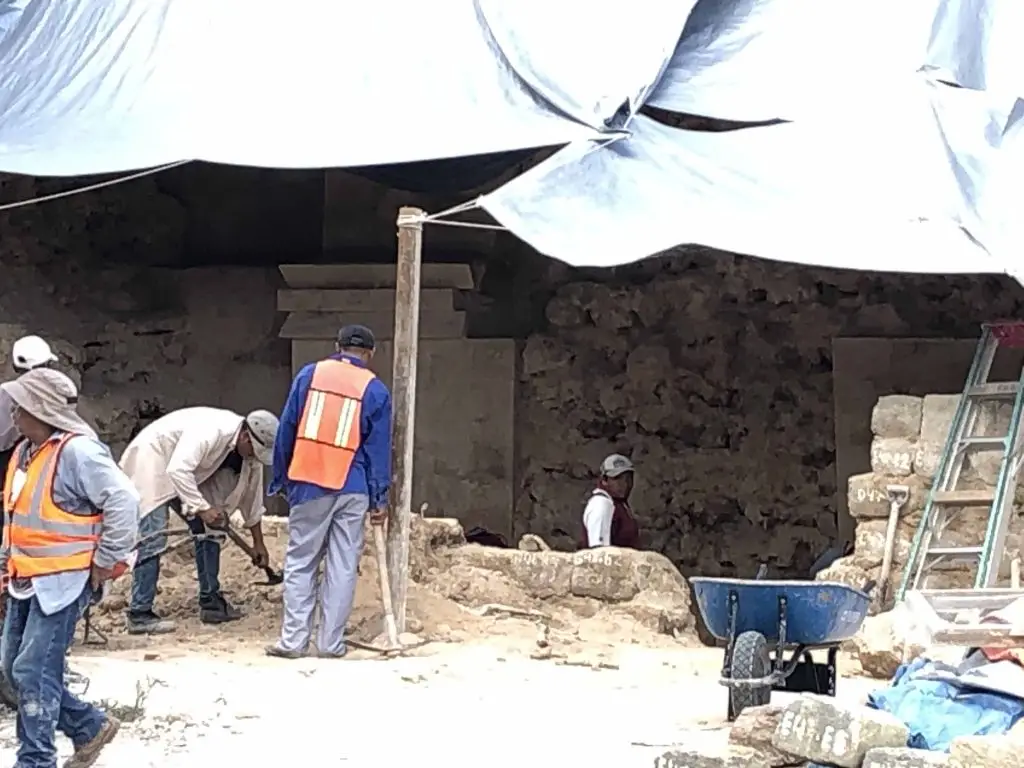
Another Recent Discovery
In 2018, archaeologists with the National Institute of Anthropology and History (INAH) also found that a large concentration of medicinal plants was cultivated outside to the Governor’s Palace.
“We found about 160 different species of medicinal plants, so we did a selective cleaning; we identified the plants, marked them and we started to conserve them."
- Jose Huchim, INAH archaeologist. Tweet
The plants could have been used to treat the following:
- snake bites
- intestinal infections
- sores
- gastritis
- stomach ulcers
- fever
- many other illnesses
References:
Aveni AF (1975) Possible astronomical orientations in ancient Mesoamerica. In: Aveni AF (ed) Archaeoastronomy in pre-Columbian America. University of Texas Press, Austin
Aveni AF (2001) Skywatchers: a revised and updated version of Skywatchers of Ancient Mexico. University of Texas Press, Austin
Aveni A, Hartung H (1986) Maya city planning and the calendar. Transactions of the American Philosophical Society, vol 76, part 7. American Philosophical Society, Philadelphia
Barrera Rubio A (1991) La Gran Plataforma del Palacio del Gobernador de Uxmal. Cuad Arquit Mesoam
Bricker HM, Bricker VR (1996) Astronomical references in the Throne Inscription of the Palace of the Governor at Uxmal. Cambridge Archaeological Journal
Kowalski JK (1987) The House of the Governor: a Maya palace of Uxmal, Yucatan, Mexico. University of Oklahoma Press, Norman
Kowalski JK (1996) Comment to Bricker HM, Bricker VR (1996) Astronomical references in the Throne Inscription of the Palace of the Governor at Uxmal. Cambridge Archaeological Journal
Kowalski JK (2003) Evidence for the functions and meanings of some northern Maya palaces. In: Christie JJ (ed) Maya palaces and elite residences. University of Texas Press, Austin
Pollock HED (1980) The Puuc: an architectural survey of the hill country of Yucatan and northern Campeche, Mexico, Memoirs of the Peabody Museum, vol 19. Harvard University, Cambridge MA
Seler E (1908) Studien in den Ruinen von Yucatan. In: Seler E (ed) Gesammelte Abhandlungen zur Amerikanischen Sprach- und Alterthumskunde, vol 3. Behrend, Berlin
Šprajc I (1990) Cehtzuc: a new Maya site in the Puuc region. Mexicon
Šprajc I (1993) The Venus-rain-maize complex in the Mesoamerican world view: part I. J Hist Astron
Šprajc I (1996a) La estrella de Quetzalcóatl: El planeta Venus en Mesoamérica. Diana, México DF
Šprajc I (1996b) Comment to Bricker HM, Bricker VR (1996) Astronomical references in the Throne Inscription of the Palace of the Governor at Uxmal. Cambridge Archaeological Journal
Šprajc I (2001) Orientaciones astronómicas en la arquitectura prehispánica del centro de México. Instituto Nacional de Antropología e Historia, México DF
Šprajc I, Sánchez Nava PF (2012) Orientaciones astronómicas en la arquitectura maya de las tierras bajas: nuevos datos e interpretaciones. In: Arroyo B, Paiz L, Mejía H (eds) XXV Simposio de Investigaciones Arqueológicas en Guatemala, vol 2. Instituto de Antropología e Historia – Asociación Tikal, Guatemala
Architecture, Restoration, and Imaging of the Maya Cities of UXMAL, KABAH, SAYIL, AND LABNÁ The Puuc Region, Yucatán, México Charles Rhyne Reed College Annotated Bibliography Uxmal.
Barrera Rubio, Alfredo
Guia official: Uxmal. Salvat Editores de México, for the Instituto Nacional de Antropología e Historia, Mexico City, 1987 (published also in English as Uxmal: Official Guide, 1990).
Published as one of the INAH official guidebooks, this 128-page handbook presented,
Blom, Frans Ferdinand
Illustrated London News. August 23, 1930
Reed.edu details
Harvey M. Bricker and Victoria R. Bricker – Astronomical References in the Throne Inscription of the Palace of the Governor at Uxmal
Pollock HED (1980) The Puuc: an architectural survey of the hill country of Yucatan and northern Campeche, Mexico, Memoirs of the Peabody Museum, vol 19. Harvard University, Cambridge MA
Kowalski JK (2003) Evidence for the functions and meanings of some northern Maya palaces. In: Christie JJ (ed) Maya palaces and elite residences. University of Texas Press, Austin, pp 204–252
Kowalski JK (1996) Comment to Bricker HM, Bricker VR (1996) Astronomical references in the Throne Inscription of the Palace of the Governor at Uxmal. Cambridge Archaeological Journal 6(2):219–221
The Yucatan Times
The Library, Special Collections, American Museum of Natural History.
Marvin Cohodas, The Bicephalic Monster in Classic Maya Sculpture
